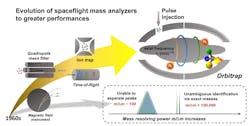Mini laser system seeks signs of extraterrestrial life
The Webb Space Telescope is offering unprecedented views of distant planets, stars, and galaxies. Now, NASA-supported research led by a team at the University of Maryland (UMD) is poised to advance our knowledge of what exists in our solar system and what lies beyond, thanks to a miniaturized laser desorption mass spectrometry (LDMS) device they developed (see video).
Their LDMS device combines a solid-state UV laser source and custom ion transfer optics with with a Orbitrap mass analyzer to provide high-resolution data about a material’s chemical composition (see Fig. 1). A pulsed UV laser removes and desorbs/ionizes small amounts of material from a planetary sample, while the Orbitrap analyzes it.
The device itself weighs under 18 pounds (8 kg), measures 11,000 cm3, and has low power consumption (41 W peak). It’s designed for sensitive and reproducible chemical analyses of organic compounds and geological phases in situ—without direct contact of sample surfaces.
“Our device is capable of comprehensive analyses of trace number of organic compounds and inorganic materials on planetary surfaces,” says Ziqin Ni, a geology postdoctoral associate at UMD. “It has been ruggedized to maintain full functionality in the extreme environments in space and is highly capable given its small size.”
The team recently published a study in Nature Astronomy, which describes their work with the LDMS device. Significantly, they showed that transient spectra can be produced and recorded using a single laser pulse, or averaged in real time using any number of laser pulses.
Analyzing chemical compositions and biosignatures
The Orbitrap analyzer offers extremely precise measurements of the mass-to-charge ratio (m/z) of charged analytes, which Ni says can efficiently separate ions of similar m/z and allows the determination of chemical constituents of unknown molecules even if they are in a sample mixture (see Fig. 2).This miniaturized instrument can detect both intact molecular ions and diagnostic fragmentation patterns of organic compounds, which the researchers say constitute complementary lines of evidence to enable the identification of potential biosignatures and infer their origin.
These analyses “support the simultaneous characterization of the organic content and the inorganic elemental composition of the surrounding mineralogy,” Ni says. “This provides multiple lines of evidence to support the search for potential biosignatures.”
Conventional systems that handle such samples and ionization methods for heritage spaceflight mass spectrometers work with pyrolysis (heating of an organic material, such as biomass) and gas chromatography coupled to electron impact ionization. “This method can extract volatile molecules through evaporation of bulk samples and decompose refractory substances through pyrolysis at temperatures greater than 200°C,” says Ni.
But that approach is “limited to analysis of volatile organic materials, because thermal degradation of refractory biomarkers hampers the identification of larger macromolecules,” she says, noting that laser beams can desorb large macromolecules at low laser fluence with minimum fragmentation and can make spatial-resolved measurements instead of bulk sample analysis.
Overcoming obstacles
The biggest obstacle the team encountered in its quest to implement the mini LDMS instrument on an astrobiology lander or rover is the need to manage the collected data in situ.
Real-time processing of the data they capture, as well as storage of the final mass spectrum, requires substantial computing power and data storage. “Spacecraft with limited data downlink rates or missions with limited lifetimes may struggle to send back sufficient data to meet the science objectives unless they use data prioritization schemes or compression techniques, including those involving machine learning algorithms,” Ni explains.
The system’s next-gen Orbitrap analyzer provides about 200X more mass resolving power and around 100X more accurate peak assignment than conventional mass analyzer-based mass spectrometers that have been deployed for spaceflight.
“Such high mass resolution and accuracy together enable the determination of biomarkers and geologic phases via exact mass measurements,” Ni says. “It also meets the performance standards of similar commercial systems and exceeds the capabilities of heritage spaceflight technologies.”
The researchers are now working to increase the reproducibility of measurements of organic abundance patterns and accuracy of elemental concentrations.
“An exploratory investigation using such a system could collect substantial amounts of chemical information from a single measurement,” Ni says. “This would enable independent, repetitive analyses, and corroboration of the presence or absence of life using multiple lines of supporting evidence.”
About the Author
Justine Murphy
Multimedia Director, Digital Infrastructure
Justine Murphy is the multimedia director for Endeavor Business Media's Digital Infrastructure Group. She is a multiple award-winning writer and editor with more 20 years of experience in newspaper publishing as well as public relations, marketing, and communications. For nearly 10 years, she has covered all facets of the optics and photonics industry as an editor, writer, web news anchor, and podcast host for an internationally reaching magazine publishing company. Her work has earned accolades from the New England Press Association as well as the SIIA/Jesse H. Neal Awards. She received a B.A. from the Massachusetts College of Liberal Arts.


